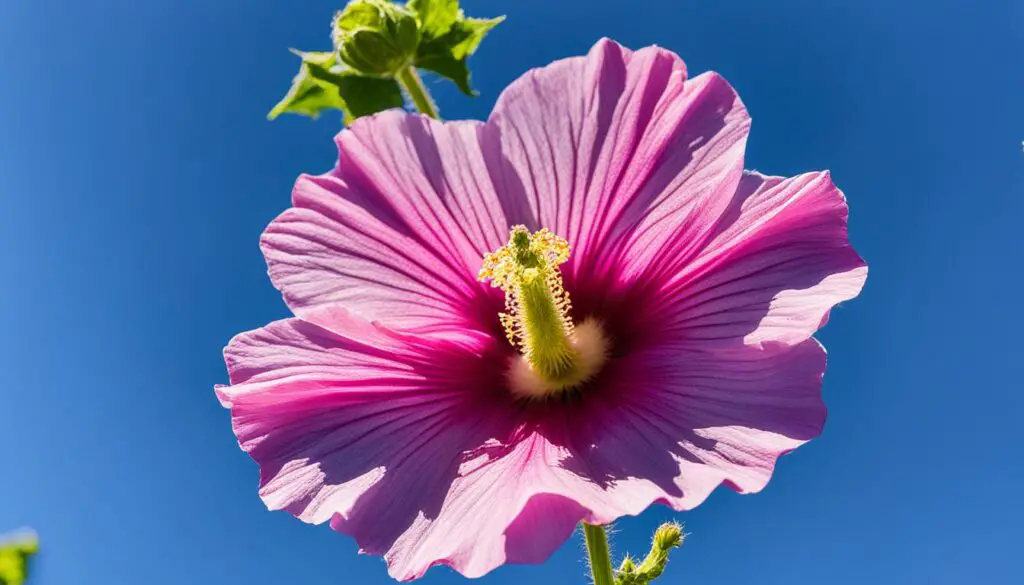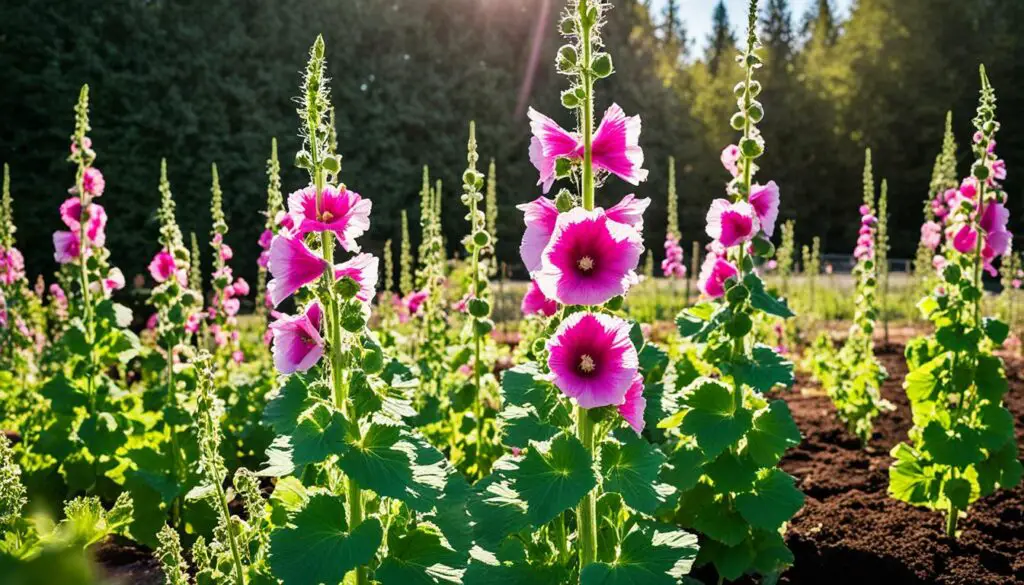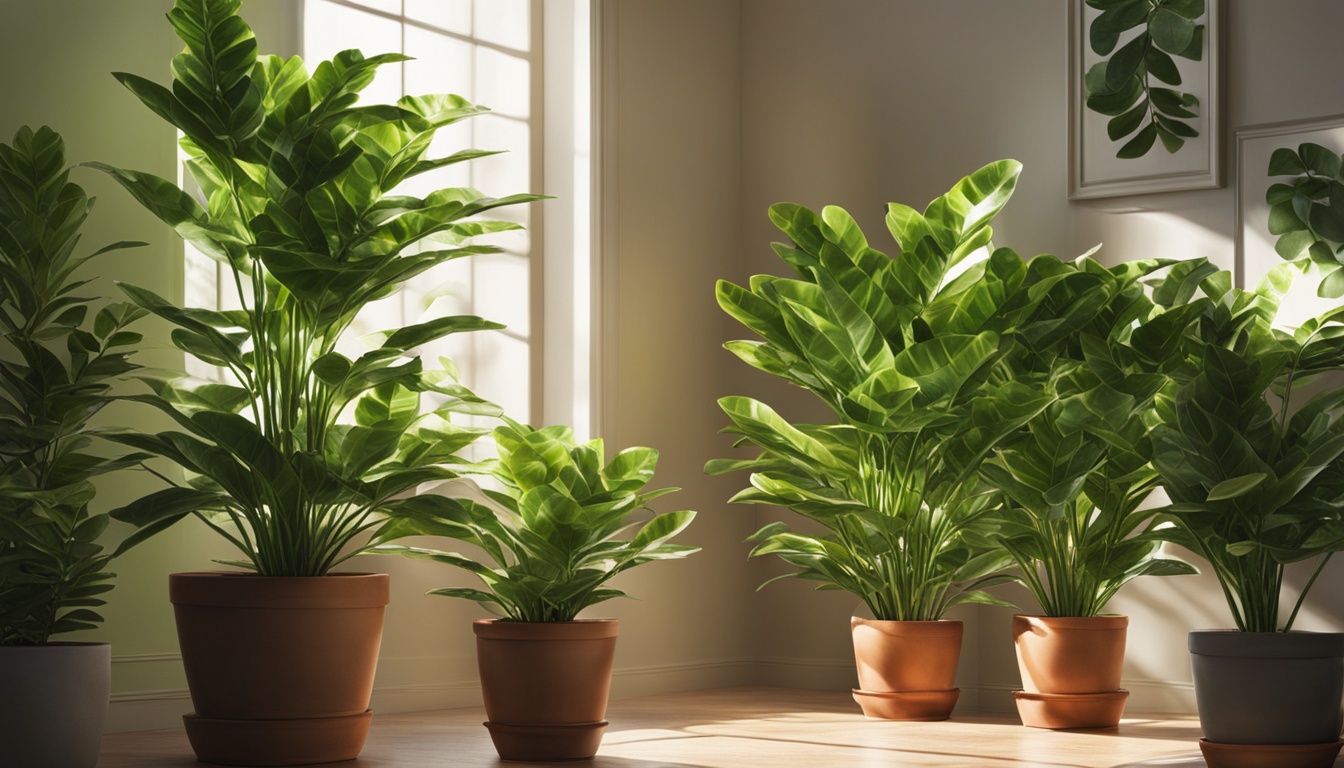Hollyhocks are a classic in cottage gardens, known for their tall stalks and bright flowers. They can act as perennials or biennials, making them versatile in the garden.
For both new and experienced gardeners, growing hollyhocks is a rewarding experience. It brings beautiful sights and attracts pollinators.

Hollyhocks love full sun and soil that drains well. They grow well in many soil types, from rich to poor.
To enjoy their beautiful flowers year after year, learn how to care for them. This includes planting, watering, and controlling pests.
Key Takeaways
- Hollyhocks are biennials that can occasionally act as short-lived perennials
- They require full sun and well-draining soil for optimal growth
- Hollyhocks are adaptable and can tolerate a range of soil types
- Proper care, including watering, fertilizing, and pest management, is crucial for their success
- Hollyhocks are a favorite of pollinators and can add a touch of vintage charm to any garden
What Are Hollyhocks?
Hollyhocks, known as Alcea, are tall, beautiful plants that have been in gardens for a long time.
They come in over 60 species, showing off colors from pink to black. These plants are a highlight in any garden.
Plant Characteristics
The most common hollyhock is Alcea rosea. Other types like Alcea setosa and Alcea rugosa also add beauty to gardens.
Hollyhocks belong to the Malvaceae family. They have big, rough leaves and can grow very tall, up to 8 feet.
These plants love the sun and do well in temperate climates. They can even handle some shade.
Hollyhocks can get quite cold-hardy, surviving temperatures as low as 0 degrees Fahrenheit. They bloom in summer, from June to August.
“Hollyhocks are a true delight, bringing a touch of old-world charm to any garden with their stately presence and captivating blooms.”
How To Grow A Hollyhock and Care
Growing hollyhocks is a great way to make your garden stand out. These tall flowers are easy to care for if you know what they need. Here’s a simple guide to help you grow and care for hollyhocks:
Planting Hollyhocks
You can start hollyhocks from seed, either directly in the garden or indoors. Sow seeds about a week before the last frost or 9 weeks before in your area.
They love well-draining soil with full sun to some shade. Make sure to plant them 12 to 18 inches apart to give them room to grow.
Watering and Feeding Hollyhocks
Watering young hollyhocks regularly keeps them healthy. Once they’re grown, they can handle some drought. Feed them every 6-8 weeks with a slow-release fertilizer to keep them strong.
Propagating Hollyhocks
To propagate hollyhocks, start with seeds after the flowers are pollinated. Wait until the seed pods dry, then collect the mature seeds.
These seeds germinate well in warm temperatures and will bloom in their second year.
With proper care and conditions, hollyhocks can be a beautiful addition to your garden for many years. Just follow these easy steps to enjoy their tall, colorful blooms.

“Hollyhocks are a true garden classic, adding a touch of old-world charm and whimsy to any landscape.”
Hollyhock Varieties
The common hollyhock (Alcea rosea) is the most popular type, but there are many others that can make a garden look great.
The Bristly hollyhock (Alcea setosa) blooms early, from April to June. The Russian hollyhock (Alcea rugosa) fights off rust well.
Other favorites include ‘Chater’s Double’ for its fluffy double flowers, ‘Blacknight’ for its almost-black blooms, and the Halo series with its two colors.
Diverse Colors and Heights
Hollyhocks have many colors like blue, pink, purple, red, white, yellow, and even black. They also come in different heights. Some can grow up to 8 feet tall, while others are only 2 to 3 feet high.
| Hollyhock Variety | Flower Color | Plant Height |
|---|---|---|
| Alcea rosea (Common Hollyhock) | Pink, purple, red, white, yellow | 4-8 feet |
| Alcea setosa (Bristly Hollyhock) | Pink, purple | 3-5 feet |
| Alcea rugosa (Russian Hollyhock) | Yellow | 4-6 feet |
| ‘Chater’s Double’ | Various | 5-7 feet |
| ‘Blacknight’ | Dark purple, almost black | 6-8 feet |
| Halo Series | Bicolor | 4-6 feet |

Whether you want tall, elegant hollyhocks or smaller, fuller ones, there’s a type for you. Mixing different hollyhock types can make your garden bright and interesting.
Caring for Hollyhocks
Hollyhocks are easy to care for once they grow. But, following a few key steps helps them do well. Deadheading spent flowers stops too much seed production and keeps the garden neat. Also, cut the stalks back to the base after they finish blooming.
Slugs, snails, spider mites, and Japanese beetles can bother hollyhocks. But, rust is the most common disease I’ve seen. It can be prevented by watering correctly and keeping air moving around the plants.
In cold areas, hollyhocks might need to be grown as annuals. Start seeds indoors and bring them outside when it’s safe. In warmer places, cut the plants back and mulch them in the fall to protect the roots.
With a bit of care, hollyhocks can be a beautiful part of your garden. They bloom from June to August. Knowing what they need lets me enjoy these lovely flowers every year.
FAQ
How can I grow and care for hollyhocks?
Hollyhocks are simple to grow from seeds. They love soil that drains well and sunlight or partial shade. Make sure they get enough water, especially when they’re young.
Feeding them regularly helps too. To keep them looking good, cut off dead flowers and trim back the stalks after they bloom.
What are the different varieties of hollyhocks?
Hollyhocks come in many types, not just the common one (Alcea rosea). You can find the Bristly hollyhock (Alcea setosa) and the Russian hollyhock (Alcea rugosa), which fights rust.
There’s also the fluffy ‘Chater’s Double’, the almost-black ‘Blacknight’, and the bicolor Halo series. These varieties offer a variety of colors and heights.
How do I care for established hollyhock plants?
Taking care of hollyhocks that are already grown is easy. Remove dead flowers to stop them from making seeds and keep the area neat. Cut the stalks back to the base after they bloom.
Keep an eye out for pests like slugs, snails, spider mites, and Japanese beetles. Also, watch for the fungal disease rust. In places with cold winters, you might need to treat them as annuals or protect them in the fall.
How can I start hollyhocks from seed?
Starting hollyhocks from seeds is straightforward. Plant seeds outside a week before the last frost or start them indoors 9 weeks before. They do best in a spot with full sun to partial shade and rich, moist soil.
Water them regularly and feed them every 6-8 weeks to help them grow well.
What are the growing conditions for hollyhocks?
Hollyhocks need full sun to partial shade and soil that drains well and is rich in nutrients. They should have consistent moisture, especially when they’re young.
Once they’re established, they can handle some drought. But, make sure they have good air flow to prevent diseases like powdery mildew and rust.



